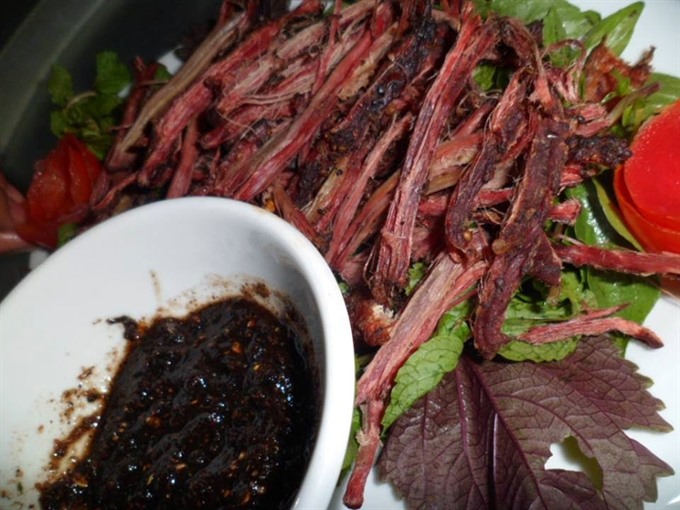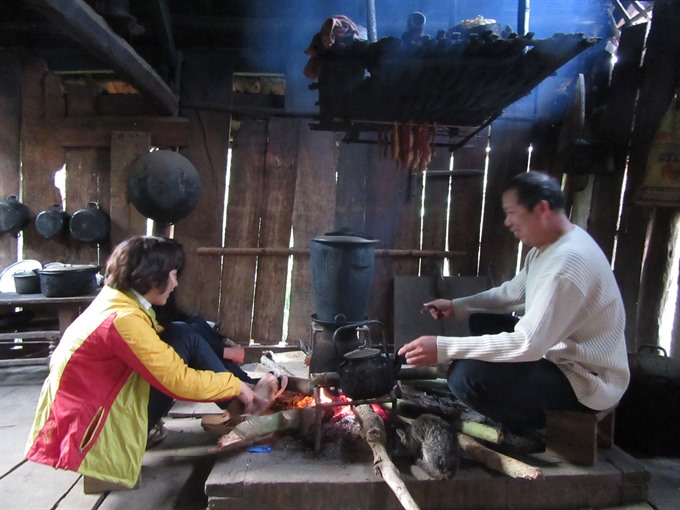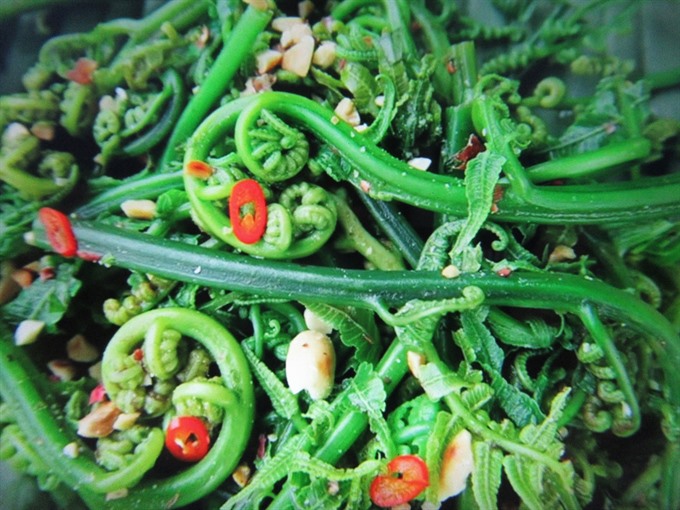The northwestern region of Việt Nam is a magical combination of alpine landscapes, ethnic culture, and bracing mountain air. This region draws travellers not only to its scenery and colourful hill tribe residents, but also to its dishes, the most popular of which is "buffalo meat hung up in kitchen" (otherwise known as smoked buffalo meat). In Vietnamese, it is called thịt trâu gác bếp. The closest Western equivalent would be beef jerky.

Smokey: Many prefer to eat "buffalo meat hung up in kitchen" with spicy lemon pepper salt, sipping cups of aromatic corn wine. — Photo dac-san-tay-bac.com
Visitors to the provinces of Sơn La, Lai Châu, Yên Bái, and Lào Cai must try the dish to round out the unique experience of this land.
Smoked buffalo meat is a specialty of the Black Thai ethnic group. Lò Văn Thỏa, a resident of Mai Sơn District in Sơn La, explains that centuries ago, his ancestors created this dish for rainy days and other times when they were forced to stay indoors.
“A long time ago, my ancestors believed that if marinated and then dried, buffalo meat, beef or pork will be kept longer. If they wanted to bring meat to the forest for a few days, they were not afraid that the meat would spoil,” he said.
Smoked buffalo meat is a time-consuming creation, requiring patience. It begins with taking a piece of buffalo shoulder, rib-eye or back meat and cutting it into smaller pieces.
It is then seasoned with salt, chili powder, ginger, and special aromatic forest seeds named mắc khén that grow in the northwestern mountains of Việt Nam. After being marinated for about two hours, the meat slices are skewered on sticks, which are then hung upstairs the kitchen. Hence the name.
The buffalo meat is dried slowly by the smoke from the kitchen, which turns it into a deep brown colour but keeps the insides looking red and fresh. About eight months or one year later, the meat skewers are taken down and the dish is ready to eat.
“We usually make this dish to treat our guests or to use for special occasions, such as the New Year Festival or a wedding,” Thỏa said.
Different dishes can be made from this dried buffalo meat. Many prefer to eat it with spicy lemon pepper salt, sipping cups of aromatic corn wine to wash down the delicacy. The salty, sweet, spicy tastes combining with the smell of the smoke are unique.

Creative chef: Lò Văn Thỏa explains about local culture around the kitchen in his stilt house, under hanging skewers of smoked buffalo meat. — VNS Photo Bạch Liên
Forest plants
Another specialty of the northwest is a salad made from a forest plant called in Vietnamese Rau dớn. Thái people call it pắc cút.
Dớn, which belongs to the fern family, often grows by streams or large rocks. Its leaves curl into a shape reminiscent of an elephant trunk.
The plant is considered a herbal remedy helpful in curing a cough, cold or constipation.
The best time to pick and eat this plant is between the flood season (late summer) and late spring.

Elephant salad: "Dớn" leaves curl into the shape similar to that an elephant trunks. — VNS Photo Bạch Liên
To make salad, local people steam its young stalks in a wooden steamer for about 20 minutes. Once cooked, they are placed in a large bowl and seasoned with different spices including lemon, chili, ginger and salt. They are then mixed with crushed peanuts.
The dish, though simple, has been a local source of pride for generations. — VNS